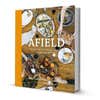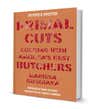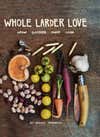Review: Four New Wild Game Cookbooks (With A Recipe From Each)
We may earn revenue from the products available on this page and participate in affiliate programs. Learn more › Lots...

We may earn revenue from the products available on this page and participate in affiliate programs. Learn more ›

Lots of books come across my desk. Stories of survival. Manuals on “manly” activities. Hunting novels. Fishing memoirs. You get the picture. I get a lot of books. The ones I enjoy receiving most, though, are cookbooks. I’m not a very inventive cook. If I don’t have a recipe in front of me, I’m lost as far as ingredient quantities or cooking times. I need instructions. And I just love the character cookbooks acquire over time–with dog-eared recipes and stain-splattered pages–and how they look on a bookshelf.
The truth, though, is that most of the cookbooks I get aren’t exactly bookshelf material. Either the recipes don’t jump out at me or the photos aren’t appetizing or the book just doesn’t feel special enough to sit on a bookshelf. But in the last couple months, four great books have landed on my desk.
If you’re looking for some new recipes for your fall harvests, you’d be doing your family table proud by purchasing any of the books that follow. And, in case you’d like to test-drive them first, I’ve included a recipe from each. Enjoy.

Afield: A Chef’s Guide to Preparing and Cooking Wild Game and Fish
David Draper and I both agree that this is one of the best wild game cookbooks we’ve seen in a long time. The photos–of food, butchering techniques, and outdoor scenes–are stunning; the essays throughout the book are well told; and Griffiths is clearly a passionate and authentic outdoorsman. And then there’s the food… Nearly 300 pages of recipes for gamebirds, waterfowl, fresh- and salt-water fish, hogs, turkeys, small game, big game, and my personal favorite: sausage and charcuterie. This is simply a beautiful book. Griffiths shared what I think is one of the book’s most compelling recipes: teal cooked and served in a Mason jar.
Teal in a Jar
This is an ideal recipe for a party. You can bake off these little ducks–sealed tightly in mason jars and slowly cooked with beans, bacon, sausage, and onions–and then reheat gently before serving. The cooking vessel also makes for a nice presentation. Quail, which are smaller, could also be used, but a teal just fits so nicely into a pint jar. –Jesse Griffiths
Ingredients
– 4 whole teal, plucked and gutted
– 4 ounces dried cannellini or kidney beans, soaked overnight in water
– 12 ounces venison sausage, or other sausage
– 4 ounces bacon, diced
– 2 onions, sliced
– 4 tablespoons sherry vinegar
– 2 teaspoons chopped fresh thyme
– 12 garlic cloves, peeled
– 2 to 3 cups game bird stock, chicken stock, or water
– Kosher salt and freshly ground black pepper to taste
– Special equipment need: 4 pint-size, wide-mouth Mason or canning jars
Directions:
1. Preheat the oven to 300 degrees.
2. In a small pot over medium-high heat, place the beans, cover with 4 inches of cold water, and bring to a boil. Boil for 20 minutes, then strain and reserve the beans, discarding the water.
3. Season the teal with salt and pepper. Remove the sausage meat from casings. Stuff each teal with equal amounts of the sausage and set aside.
4. In a small pan over medium heat, cook the bacon until it is crisp and rendered, about 10 minutes. Add the onions and cook for about 5 minutes, stirring occasionally. Add the vinegar and thyme, cook for 2 minutes, and set aside.
5. Place equal amounts of the onion mixture in each jar, followed by a stuffed teal. Add equal amounts of the beans and 3 garlic cloves to each jar. Ladle in as much stock as possible, leaving about a 1/2-inch space at the top. Place the lids on the jars and slightly tighten the screw bands.
6. Place the jars in a pan, add hot water to come halfway up the sides, and bake for 4 hours.
7. Carefully remove the jars from the oven. If serving later, cool unopened jars completely, then refrigerate up to 2 days. To reheat, place the jars in a pan and add hot water to come halfway up the sides. Simmer for 1 hour, or until the contents are bubbling.
8. To serve, let the hot jars cool slightly, and carefully open with a towel to hold the jar and lid. Serve from the jars or invert the teal into a bowl. Serves 4
Recipe courtesy of Afield: A Chef’s Guide to Preparing and Cooking Wild Game and Fish, by Jesse Griffiths (Welcome Books).

Open Range: Steaks, Chops & More from Big Sky Country
I have a soft spot for Montana. I lived there for a year in my twenties and dream of going back. So this cookbook, written by a couple of buddies who met at a restaurant near Bozeman where the menu read, “WE DO NO GUARANTEE THE FLAVOR OF MEAT COOKED MEDIUM-WELL OR MORE,” hit home with me. This book covers more than just wild game, but the fish and game they do cover all sounds delicious–especially the Venison Saurbraten below. And Jay Bentley and Patrick Dillon seem to get the kind of cookbook I enjoy. In the introduction they write: “Grease stains, wine spots, and dog ears will make us happy.” Same here.
Venison Sauerbraten
It seems as thought nobody loves hunting as much as the Germans, and my friend Hans personifies this passion. When he comes to Montana during hunting season, he can barely contain himself as we drive down back roads scouting for herds of deer grazing in the hayfields. He dreams of the perfect buck; I dream of the sauerbraten he’s going to cook when the hunt is over.
Hans likes to cut up his venison in the European style, boneless and seamed, which means that the shape and size of each piece is defined by the location of the muscles and sinews. They typical Montana game processor we take our meats to tends to use meat saws to cut through bones and across the grain. The European method, on the other hand, results in cuts that are not only more versatile but are better-tasting because by removing the bones whole, you avoid having any bone residue left behind, which can impart a bitter and gamey flavor to the meat.
The best cuts for sauerbraten are the large rounds and sirloins from the rear legs, or even a whole leg. Larger cuts lend themselves better to the long braising process. This recipe works equally well with elk, bison, or moose.
The marinating process should be at least 5 days and I usually like to do it for a week. Believe me, this is the ultimate winter dinner. It should be accompanied with sweet red cabbage, and the traditional side dish of spaetzle or potato dumplings. When I don’t want to go to all that trouble, simple egg noodles work just fine. –Jay Bentley
Ingredients
Marinade
– 5 to 6 lbs. venison round roast
– 2 cups red wine vinegar
– 2 cups red wine
– 10 whole garlic cloves
– 10 juniper berries (substitute 1 cup good-quality gin)
– 5 bay leaves
– 1 large carrot, sliced
– 2 large yellow onions, sliced
– 3 Tbsp. freshly-cracked black pepper
– 1/2 cup packed dark brown sugar
– 2 Tbsp. kosher salt
Sauerbraten
– 1/2 cup canola oil, divided
– 1 large yellow onion, finely diced
– 2 large carrots, finely chopped
– 2 stalks celery, finely chopped
– 3 Tbsp. all-purpose flour
Finishing Sauce
– 4 to 6 gingersnaps, pulverized in a food processor
– Fine salt and freshly-ground black pepper to taste
Directions:
1. In a large pot, combine the vinegar, wine, garlic, juniper berries, bay leaves, carrot, onion, pepper, sugar, salt, and 1 cup of water and bring the marinade to a boil. Stir to dissolve the sugar, then remove from the heat and allow it to cool to room temperature.
2. In a nonreactive bowl or a large resealable plastic bag, place the meat in the marinade and allow it to marinate, covered, in the refrigerator for 5 to 7 days. If the meat isn’t completely submerged in the liquid, turn it occasionally.
3. Remove the meat from the marinade (reserving marinade) and dry the outside with paper towels. Preheat a few tablespoons of the oil in a large Dutch over high heat. When the oil is very hot, sear the outside of the meat on all sides to get a good crust. Set the meat aside and saute the onion, carrots, and celery until they are slightly browned, about 5 minutes, then add the flour. Stir the flour into the vegetables and cook it until it has colored and smells nutty, about 4 minutes; be careful not to let the flour burn. (If you burn the flour, just start over with more vegetables as burned flour will impart a bitter taste that cannot be eliminated.)
4. Add 3 cups of the reserved marinade and a cup of water to the mixture. Stir to get all of the cooked bits off the bottom of the pot and return the meat to the pot. The liquid should come three-quarters of the way up the sides of the venison. If it doesn’t, add a little more water.
5. Bring the pot a boil over medium-high heat, reduce to a slow simmer, the cover and cook for at least two hours. Check occasionally; when done, then meat should be fork-tender. When ready to serve, carefully lift the meat out of the pot to a serving platter, cover, and keep warm in a low oven.
6. To finish with the sauce, add all of the remaining marinade to the pot and mix it well. Cook over high heat to reduce, and stir when needed to keep it from burning on the bottom. Sometimes, I like to strain the vegetables out of the remaining liquid at this point, although I sometimes choose to puree everything in a blender or with an immersion blender for a thicker gravy (fish out the juniper berries and bay leaves first, and discard). Return the resulting liquid to the pot and stir in the gingersnap crumbs. If the sauce is too thick, thin out with some water. Add salt and pepper, adjusting seasoning to taste.
7. Cut the meat into 1/4-inch-thick slices, across the grain, and serve on warm plates with a generous amount of sauce.
Recipe courtesy of Open Range: Steaks, Chops & More from Big Sky Country, by Jay Bentley and Patrick Dillon (Running Press).

Primal Cuts: Cooking with America’s Best Butchers
With a title like this, do I really need to say more? While Primal Cuts isn’t all about wild game, there’s enough in the book to make this one worthwhile–that’s assuming, you know, that you’re a carnivore. My obsession with butchery probably explains why I like this book so much. Marissa Guggiana profiles the country’s top butchers–who also know a thing or two in the kitchen, as they all share their best recipes. I have many weaknesses when it comes to food, but none bigger than the sandwich. The one below combines two of my favorite flavors: duck and beer.
Scott Leysath’s Duck Breast and Beer Sandwich
How’s that for an attention grabber? Well-seasoned duck breasts simmered in beer with sweet onions and garlic–oh, my! I recommend enjoying this recipe with a full chilled tankard of your favorite foaming ambrosia. The sandwiches are handy for the outdoors, but you can also serve the duck with wild rice. –Scott Leysath
Ingredients
– 1 lb. boneless duck breasts, skinned
– 3 Tbsp. olive oil
– 2 medium yellow onions, sliced into thick rings
– 2 Tbsp. light brown sugar
– 4 cloves garlic, chopped
– 2 Tbsp. grainy mustard
– 1 red bell pepper, sliced into thin strips
– Pinch chili flakes
– 1 cup flat dark beer
– 4 Tbsp. mayonnaise
– 4 sandwich rolls
– 4 lettuce leaves
– 4 tomato slices
– 4 slices provolone cheese (or your favorite)
– Salt and pepper
_**
Directions:**_
1. Season the duck breasts liberally with salt and pepper. Heat 2 tablespoons of the oil over high heat in a large skillet and sear breasts quickly on both sides, but not past rare. Remove and set aside.
2. Add remaining oil and onions. Reduce heat to low and cook onions 4 to 5 minutes. Add brown sugar and stir. Cook until sugar has melted and coated the onions, about 3 to 4 minutes more. Add garlic and next four ingredients and simmer until liquid is reduced to about 1/4 cup.
3. Return breasts to pan, cover, and cook to medium rare, checking at 5 minutes. Remove duck and slice thinly on the diagonal.
4. Spread mayonnaise on rolls and add lettuce, tomato, and cheese. Divide duck, peppers, and onions among sandwiches. Serves 4
Recipe courtesy of Primal Cuts: Cooking with America’s Best Butchers, by Marissa Guggiana (Welcome Books).

Whole Larder Love: Grow, Gather, Hunt, Cook
In his introduction to Whole Larder Love, Rohan Anderson writes: “A warning to those who are not regular readers of my blog: I have attitude, I have opinions.” I wasn’t a regular reader, but I will be now. (For a taste of Anderson’s attitude, just wait till you get to the end of his recipe introduction below.) This is a thoughtful book with an emphasis on seasonal eating and recipes for the hunter, angler, gardener, and forager. Since we’ve already covered recipes for waterfowl and deer, I thought something with small game would be good. I have approximately 19 different jars of mustard in my fridge at home, so this recipe had my name written all over it.
Rabbit with Mustard Sauce
Braised rabbit recipes were a dime a dozen during the tough post-war era, as rabbit was plentiful and–better yet–free (minus the cost of a bullet). Wild rabbit is very lean and needs to be cooked longer than its farmed equivalent but tastes just as good.
The long cook of this meal is one of those great excuses to do nothing much…other than maybe taking a few extended sips from a fine glass of pinot noir. The mustard sauce rabbit is one of my regular ways to took this beasat and it’s always a crowd pleaser. It’s sure to have your guests asking for seconds. Reply by handing them the gun and telling them to get busy.
This rabbit sits nicely on a bed of mashed potatoes, which most people know how to make, so I won’t tell you how to suck eggs. –Rohan Anderson
Ingredients
– 6 rabbit hind legs
– 2 oz. butter
– Olive oil
– 5 1/4 oz. bacon, chopped
– 4 onions, chopped
– 5 garlic cloves, chopped
– Plain flour
– 1/2 cup white wine
– 2 cups chicken stock
– Fresh thyme, chopped
– Fresh bay leaf
– 2 Tbsp. of Dijon mustard
– 1/2 cup parsley, chopped
– Salt and pepper to taste
Directions:
1. Preheat your oven to 350 degrees.
2. In a baking dish (cast iron or ceramic with lid) on a stovetop, heat the butter and olive oil, and brown the bacon, onion, and garlic for around 5 minutes. When done set aside.
3. Dust the rabbit in flour and brown in the baking dish for a few minutes on each side. Deglaze the pot with the wine on high heat. Scrape the sides of the dish into the mix as this will add to the overall flavor.
4. Return the bacon, onions, and garlic to the oven dish.
5. Add the chicken stock, thyme, and the bay leaf. Mix the ingredients well.
6. Pop the lid on the dish and bake for 2 hours. Flip the legs over after the first hour.
7. Remove the dish from the oven and check with a fork to see if the meat comes off the bones easily. If so, remove the rabbit pieces and wrap in aluminum foil and set aside.
8. Place the oven dish on the stove at high heat. Stir and reduce for a few minutes, until you have a thick consistency. Add the Dijon mustard and fresh chopped parsley. Stir well.
9. Serve the rabbit legs on top of a dollop of mashed potatoes and drizzle over the mustard sauce.
Recipe courtesy of Whole Larder Love: Grow Gather Hunt Cook, by Rohan Anderson (powerHouse Books).
